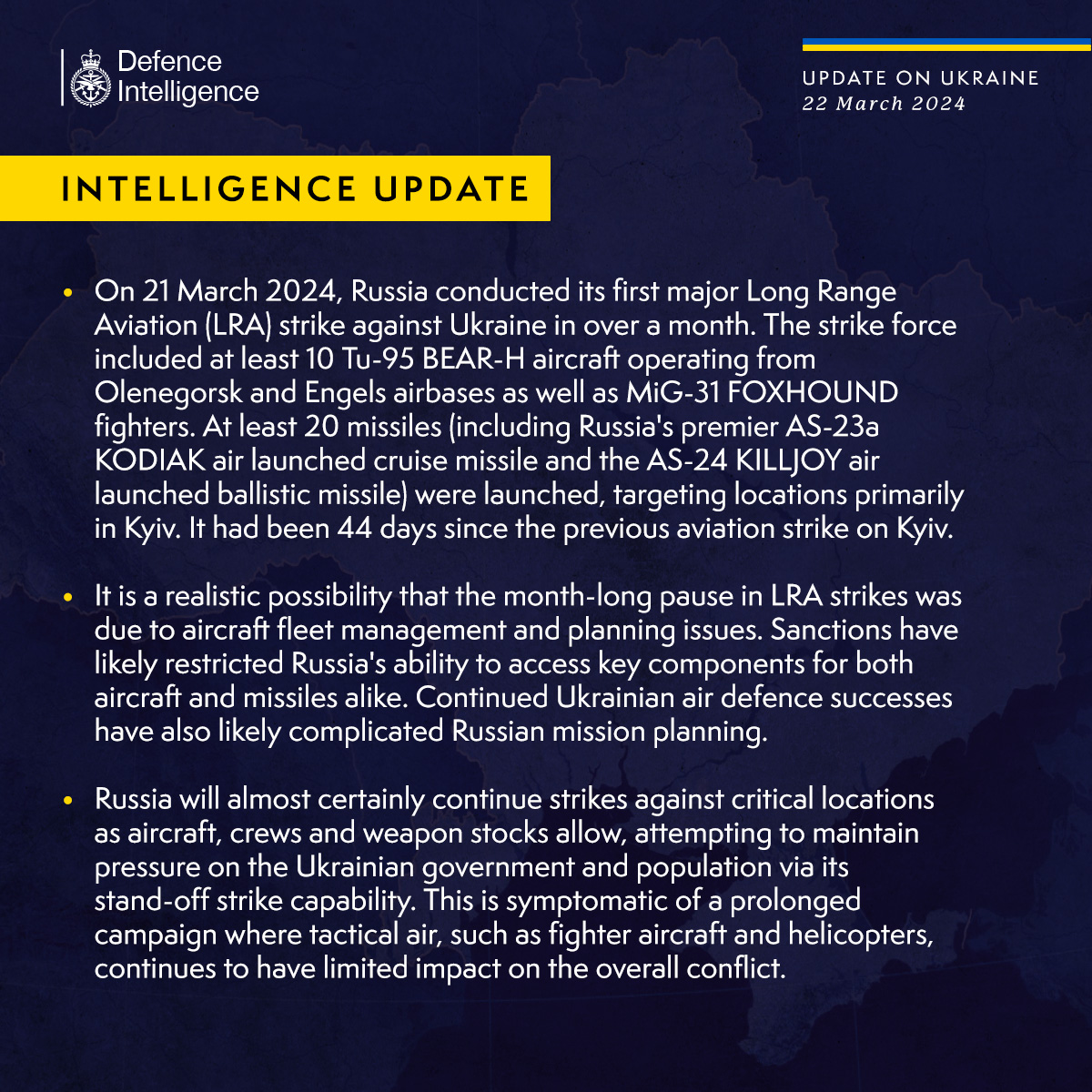After a major lull, Russia launched its largest missile attack on Kyiv and the surrounding area in weeks, causing widespread blackouts across the country.
Gripen vs F-16: UK Bets On SAAB Fighters To Outflank US Fighting Falcons For Thailand Deal
The latest intelligence update published by the UK Ministry of Defense on Platform X stated that Russia launched its first major long-range aerial strike on Ukraine after over a month on March 21. These aerial strikes were carried out using strategic Russian bombers and tactical aircraft.
The intelligence assessment reveals that the strike force included at least ten Tu-95 BEAR-H aircraft operating out of the airbases at Olenegorsk and Engels, along with MiG-31 Foxhound fighters that are capable of firing air-launched hypersonic ballistic missiles.
According to details published by the British MoD, at least twenty missiles were fired, mostly aimed at Kyiv, including Russia’s revered AS-23a KODIAK air-launched cruise missile and the AS-24 KILLJOY (Kinzhal) air-launched ballistic missile.
EurAsian Times could not independently verify these details. However, this attack comes about 44 days after the last attack on Kyiv.
On its part, the Russian MoD acknowledged that its aerospace forces hit high-precision weapons at the decision-making centers of the Armed Forces of Ukraine. The ministry specified, “The goals of the strike have been achieved; all the objects have been hit.”
Russian forces conducted the last missile strike on January 23, when the capital city of Kyiv and the Kherson region came under attack. At the time, Ukrainian President Volodymyr Zelenky said in an address that Russia had launched nearly 40 missiles of different types in “another combined strike to try to circumvent our air defense system.”
However, concerning the latest strike, the British intelligence assessment noted that it is conceivable that problems with aircraft fleet management and planning caused the one-month hiatus in long-range aerial strikes.
Presumably, Russia’s access to essential parts for missiles and aircraft has been hampered by sanctions, which means its mission planning has become more complex against a guarded Ukrainian air space with an array of air defense systems deployed.

“Every day and every night, there is such terror. The world’s unity can stop it when it helps us with air defense systems. Now we need this defense here in Ukraine,” President Volodymyr Zelenskiy said on the Telegram messaging app.
The intelligence update further noted that Russia is likely to keep using its stand-off strike capacity to exert pressure on the Ukrainian government and populace by carrying out strikes against strategic targets as long as aircraft, crews, and weapon stockpiles permit.
This is indicative of a protracted campaign in which tactical air vehicles—fighters and helicopters, for example—continue to have little effect on the broader fight.
Russia Strikes F-16 Airbase
Another aerial attack was launched shortly after, on March 22. This attack was largely aimed at Ukraine’s energy infrastructure, hitting a vast dam, killing at least five people, and leaving more than a million others without electricity.
The Ukrainian Defense Ministry issued a detailed list of missiles used by Russia in the strike. This included 12 Iskander ballistic missiles, 40 Kh-101/Kh-555 cruise missiles, five Kh-22 cruise missiles, seven Kh-47 M2 (Kinzhal) aeroballistic missiles, 22 S-300/S-400 anti-aircraft missiles, and two Kh-59 guided cruise missiles.
Besides the missiles, Russia also fired about 63 Shahed kamikaze drones against Ukraine.
Overnight, Ukrainian forces shot down 92 of the 151 russian aerial targets.
The terrorist state attacked Ukraine with:
•63 Shahed UAVs
•12 Iskander-M ballistic missiles
•40 Kh-101/Kh-555 cruise missiles
•5 Kh-22 cruise missiles
•7 Kh-47 M2 (Kinzhal) aeroballistic missiles… pic.twitter.com/orRb9pSd5I— Defense of Ukraine (@DefenceU) March 22, 2024
Russia reportedly launched these attacks in response to Ukraine’s raids, which were aimed at disrupting the Russian presidential election. However, the Kremlin visibly took the fight further than just that, as it also acknowledged hitting the Ukrainian airbase, which will host incoming F-16 fighters.
One of the Russian strikes on Ukrainian military and energy facilities targeted the Starokonstantinov military airfield in the Khmelnytsky region, where the Armed Forces of Ukraine are getting ready to receive the F-16 aircraft, RIA Novosti reported.
Denmark’s Defense Minister Troels Lund Poulsen announced last month that the first F-16 fighter jets should be delivered to Ukraine’s air force by this summer. The Netherlands, however, would deliver the aircraft pledged to Kyiv by fall.
Ukraine has been making efforts to host and fly the F-16s on a war footing. The first set of ten Ukrainian pilots has finished their initial flight training in the United Kingdom.

However, Russia has warned on multiple occasions that it would bomb all Ukrainian airfields that host the F-16s. In August last year, it said that Ukraine lacked the infrastructure to host the F-16 fighting falcons, but if it attempted to construct the requisite infrastructure, it would be destroyed before it was even fully built.
Nearly all the airfields that may host the jets are believed to be within the range of Russian missiles. It has already struck Ukrainian air bases housing MiG-29 fighters with simple weapons like the Lancet drones, which are nearly 60 kilometers from the frontline in the south.
Experts have also warned that once the location of these air bases where the F-16s are stationed is established by Russia, their troops could use their limited inventory of long-range missiles to hit these bases and annihilate the F-16s while they are still parked on the ground.
Against that backdrop, the recent missile attack likely sends a message that Ukrainian energy infrastructure and its F-16 air bases are both vulnerable to Russian missile attacks.
- Contact the author at sakshi.tiwari9555 (at) gmail.com
- Follow EurAsian Times on Google News





